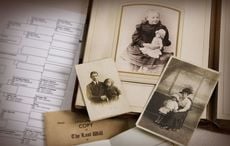“We know what they gave up. They gave up their countries and in some cases their languages. They worked at the lousiest, rottenest jobs in order to put food on our tables. We have to honor that for the rest of our lives.”
That’s what Pete Hamill, Brooklyn born author and son of Irish immigrant parents, said of our immigrant ancestors.
I knew little about those who came before my grandparents. I didn’t know their names or their places of birth. I didn’t know their joys and disappointments. There were a few photos but no letters, no family heirlooms, and hardly a story.
Through birth, baptismal, marriage and death certificates, and the US Census, I cobbled together what I could of their lives. One of the lives was that of my great-great-grandfather John Coakely.
I learned that John came from Ireland, but where in Ireland I still don’t know. I learned he lived on Cherry Street on the Lower East Side and died in 1903 at the age of 48. And I learned that he was a street sweeper.
How much can one study or write about a street sweeper? I began to consider New York in the mid-nineteenth century, when hordes of immigrants were arriving our shores, swelling the ranks of the city’s poor to unprecedented numbers.
Thousands of immigrants lived in squalor, many below ground level in cellars often flooded with rainwater and sewage. Swine roamed the street and it wasn’t until 1867, the year the Board of Health was established, that an ordinance prohibited owners from allowing livestock to roam free.
By all accounts, the city in the nineteenth century was filthy. Household garbage was tossed behind tenements and roads were lined with animal carcasses and ashes. The stench must have been unbearable. Horse manure and urine caused severe health problems as horses bolted through the streets, spraying mud, and much worse, on pedestrians. Indoor plumbing arrived slowly in the poorest neighborhoods and alleys, intended as entranceways to a rear house, often could be mistaken for a sewage-ditch for slops, garbage and waste.
These were the streets my great-great-grandfather John Coakley swept. Pete Hamill was right; the immigrant took the rottenest jobs. I couldn’t imagine a worse or less prestigious job; however, the poor can’t always afford prestige as a consideration.
It wasn’t until George Waring was hired as commissioner of the Department of Street Cleaning in 1895 that things began to change. Waring developed an organization that promoted cleanliness, respect for the city’s ordinances and help spread hygiene information. But one of the first things Waring did was instill a sense of pride in his workforce by issuing all employees new sparkling white uniforms. The uniforms served the additional purpose of attracting the public’s attention to the activities of the Street Cleaning Department. The street cleaners became known as “White Wings” for their immaculate appearance and soon New York’s streets took on an entirely new look.
Researching the history of New York City I became fascinated with the work of two photographers, Jacob Riis and Alfred Stieglitz. Riis, a social reformer, argued for better housing, adequate lighting and sanitation, and the construction of city parks and playgrounds; he attempted to educate and rouse the public from its lethargy through his photographs and journalistic skills. He photographed (as seen at the top of this article) the slums of the city and the squalid conditions in which so many lived and published them in a book “The Other Half.” Viewing his photos, I’ve often wondered, were my ancestors, including John Coakley, among “the other half?”
Stieglitz, on the other hand, searched for the art in photography. He began photographing New York street scenes in rain, fog and snow—misty, suggestive and evocative—in an effort to create a contemplative mood. He was looking for “picturesque bits” and “metropolitan scenes” as he called them, trying to create a feeling beyond the precise subject of the picture. Unlike Riis, Stieglitz emphasized the look rather than the content.
Both Riis and Stieglitz capture the living theater of the street and show visible evidence of the immigrant’s plight. Riis’ photographs tend to be graphic while Stieglitz’s are subtler. And it’s one of Stieglitz’s photos—Spring Showers-The Street Cleaners—that sculpts the model through which I view John Coakley’s world. The photo, an everyday moment in the life of a “White Wing” evokes memory and reflection and somehow brings a sense of dignity to my great-great-grandfather’s life.
“If it falls your lot to be a street sweeper, sweep streets like Michelangelo painted pictures, sweep streets like Beethoven composed music…like Shakespeare wrote poetry. Sweep streets so well that all the hosts of heaven and earth will have to pause and say: Here lived a great street sweeper….”
- Martin Luther King, Philadelphia, October 26, 1967.
Listen as Charles R. Hale narrates his great-great-grandfather's story:
My Ancestor's "White Wings" from Charles R. Hale on Vimeo.
---
Charles R. Hale was born, raised and educated in New York. He is a former partner of a NYC based consulting firm Hale, Borenstein Ltd. Charles, along with Niamh Hyland, is a cofounder of Artists Without Walls, an organization purposed to inspire, uplift and unite people and communities of diverse cultures through the pursuit of artistic achievement. His film “Walls: We Are Not Forgotten,” about the life of singer Judy Collins, was presented at the 2012 Eugene O’Neill Award ceremony honoring Ms. Collins. In 2013 the City University of New York honored Charles for ”Outstanding Service to New York and Irish America.”




Comments